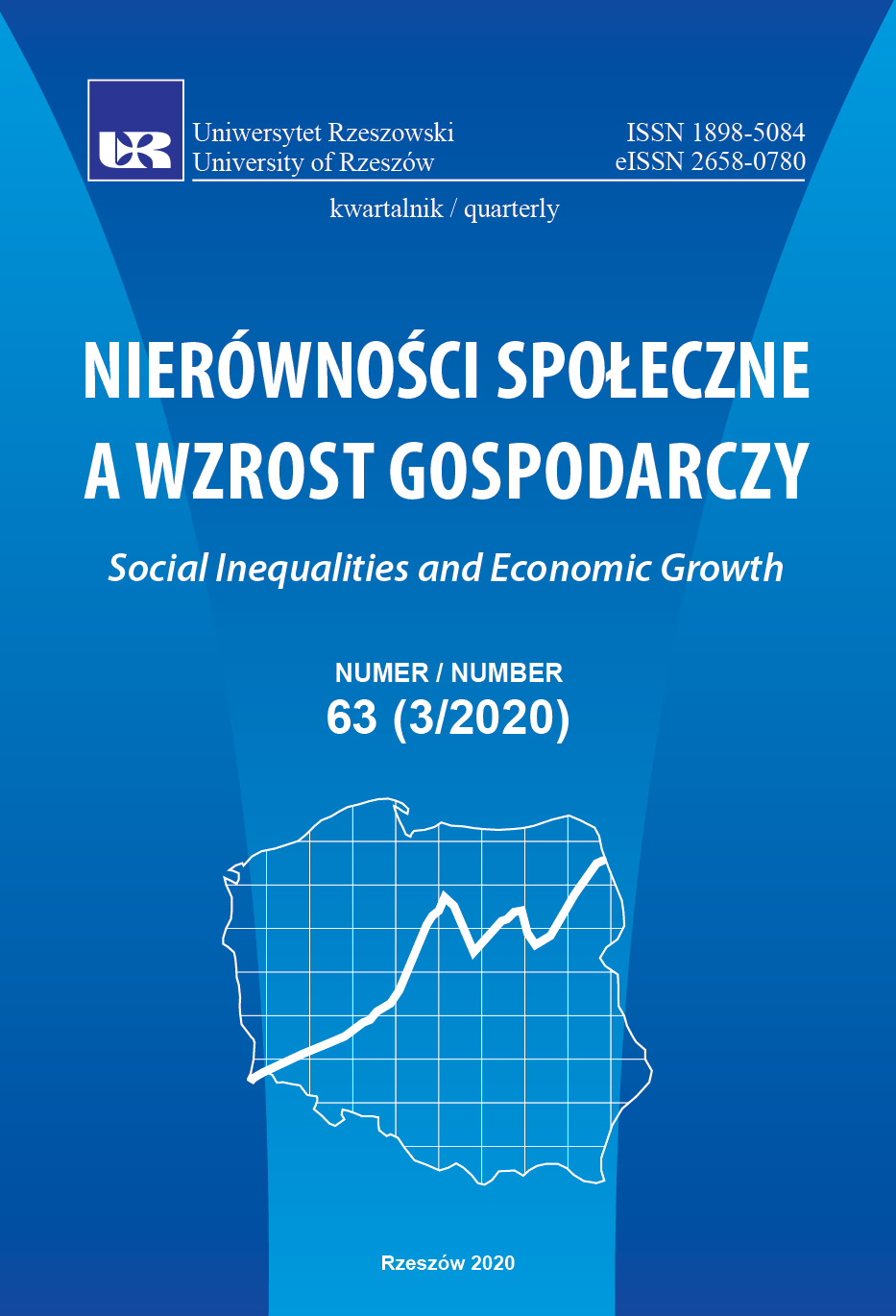Population instability and EU-production function anomaly
DOI:
https://doi.org/10.15584/nsawg.2020.3.8Keywords:
production function, EU population, economic growth, new member states, growth modeAbstract
The purpose of the study is to present the problematic situation when capturing the economic growth mechanism in the European Union. Due to intra-EU migration, the prominent production function framework fails to deliver consistent results. Estimation of structural parameters on data covering the post-accession period up to 2016 delivered a negative (!) assessment of the contribution of “labour” to output for most of the new member states. This result called for further investigations, and a holistic interpretation. It seems that this is the first time a methodological study on the production function framework offers an explicit formulation of the requirements for this method to be effectively employed in output investigations. In short, the production function can be used for cases where the growth mode is extensive, while arguments display declining or ascending trends. However, when the growth mode is intensive, while any of the arguments decline in value, this particular framework will become invalid for capturing the growth mechanism. The observed failure of the production function calls for introducing a new term to the economic growth literature: EU-production-function-anomaly. The method seems to be a far-reaching simplification. The reason for utilizing a very general formulation (excluding human capital and technology) is motivated by the focus on the demographic developments responsible for the anomaly.
Downloads
References
Ackerknecht, E. H. (1965). History and Geography of the Most Important Diseases. New York: Hafner Publishers.
American Enterprise Institute (2018). China Global Investment Tracker. Retrieved from: http://www.aei.org/china-global-investment-tracker/ (2018.02.28).
Brecke, P. (2009). Violent Conflicts 1400 A.D. to the Present in Different Regions of the World, paper presented at the 1999 Meeting of the Peace Science Society (Interna¬tional) on October 8–10, 1999 in Ann Arbor, Michigan.
Brecke, P. (2012). Conflict Catalog. Retrieved from: http://www.cgeh.nl/sites/default/ files/Conflict%20Catalog%2018%20vars.xls (2018.02.20).
Browne, G. W. G. (1943). The Production Function for South African Manufacturing Industry. South African Journal of Economics, (December).
Calic, M.–J. (2012). Ethnic Cleansing and War Crimes, 1991–1995. In: Ch. W., Ingrao, T. A., Emmert (Eds.), Confronting the Yugoslav Controversies: A Scholars’ Initiative (pp. 139–140). West Lafayette, IN: Purdue University Press.
Daly, P., Douglas, P. (1943). The Production Function for Canadian Manufacturers. Jour¬nal of American Statistical Association, 39 (June), 178–186.
Douglas, P. H. (1976). The Cobb-Douglas Production Function Once Again: Its History, Its Testing, and Some New Empirical Values. Journal of Political Economy, 84(5), 903–916.
Fusco, I. (2007). The causes of the epidemic. In: F. Angeli (Ed.), Plague, demography and taxation in the Kingdom of Naples of XVII century. Milan: Franco Angeli.
Goldman, W. Z. (2011). Inventing the Enemy: Denunciation and Terror in Stalin’s Russia. New York: Cambridge University Press. DOI: 10.1017/CBO9780511994906.
Gregg, Ch. T. (1985). Plague: An Ancient Disease in the Twentieth Century. Albuquerque: University of New Mexico Press.
Hays, J. N. (2005). Epidemics and pandemics their impacts on human history. Santa Bar¬bara, California: ABC-CLIO.
Jorgenson, D. W., Ho, M. S.,Samuels, J. D. (2017). Education, Participation, and the Revival of U.S. Economic Growth. National Bureau of Economic Research Working Paper, 22453, 1–57. DOI: 10.3386/w22453.
LeMay, M. C. (2016). Global Pandemic Threats: A Reference Handbook: A Reference Handbook. Santa Barbara California, Denver Colorado: ABC-CLIO.
Leser, C. E. V. (1955). Production Functions and British Coal Mining. Econometrica, 24(4), 442–446. DOI: 0012-9682(195510)23:4<442:PFABCM>2.0.CO;2-P.
Lomax, K. S. (1950). Production Functions for Manufacturing Industry in the U.K. American Economic Review, 40.
Mankiw, G., Romer D., Weil, D. (1992). Contribution to the Empirics of Economic Growth. Quarterly Journal of Economics, 107(2), 407–437. DOI: 10.2307/2118477.
Masui, M., Młodkowski, P. (2019). Labor Market Flexibility in Japan 1960-2018. Nierów¬ności Społeczne a Wzrost Gospodarczy (Social Inequalities and Economic Growth), 60(4), 115–143. DOI: 10.15584/nsawg.2019.4.8.
Młodkowski, P. (2018). Economic Growth in EMU before and after 1999. Nierówności Społeczne a Wzrost Gospodarczy (Social Inequalities and Economic Growth), 54(2), 21–33. DOI: 10.15584/nsawg.2018.2.2.
Młodkowski, P. (2019). Economic Growth Projection for the EU by 2030. European Inte¬gration Studies, 13, 61–69. DOI: 10.5755/j01.eis.0.13.2370.
Niewyk, D. (2000). The Columbia Guide to the Holocaust. Columbia: Columbia Univer¬sity Press. DOI: 10.7312/niew11200.
OECD (2017). Euro Area – Economic forecast summary (November).
Paneth, N., Vinten-Johansen, P., Brody, H., Rip, M. (1998). A rivalry of foulness: offi¬cial and unofficial investigations of the London cholera epidemic of 1854. American Journal of Public Health, 88(10), 1545–1553. DOI: 10.2105/AJPH.88.10.1545.
Patterson, K. D. (1993). Typhus and Its Control in Russia 1870–1940. Medical History, 37, 361–381. DOI: 10.1017/S0025727300058725.
Porter, S. (2001). 17th Century: Plague. Gresham College. Accessed March 22nd 2018. Retrieved from: https://www.gresham.ac.uk/lectures-and-events/17th-century-plague (2018.02.20).
Rosefielde, S. (1983). Excess Mortality in the Soviet Union: A Reconsideration of the Demographic Consequences of Forced Industrialization, 1929–1949. Soviet Studies, 35(3), 385–409.
Ross, D. (Ed.). UK travel and heritage – Britain Express UK travel guide. The London Plague of 1665. Retrieved from: http://www.britainexpress.com/History/plague.htm (2018.02.22).
UCLA School of Public Health. (2018). Asiatic Cholera Pandemic of 1846–63. Retrieved from: http://www.ph.ucla.edu/epi/snow/pandemic1846-63.html (2018.02.22).
United States Holocaust Memorial Museum. (2010). Axis Invasion of Yugoslavia – Cro¬atia. Holocaust Encyclopedia. Retrieved from: https://encyclopedia.ushmm.org/ (2018.02.12).
Werth, N. (2010). The NKVD Mass Secret National Operations (August 1937 – November 1938). Online Encyclopedia of Mass Violence. Retrieved from: http://www.sciences¬po.fr/mass-violence-war-massacreresistance/en/document/nkvd-mass-secret-nation¬al-operations-august-1937-november-1938 (2018.02.12).
Williams, J., Douglas, P. (1945). Production Function. Economic Record, (June).
Downloads
Published
How to Cite
Issue
Section
License
Copyright (c) 2020 University of Rzeszow

This work is licensed under a Creative Commons Attribution-ShareAlike 4.0 International License.


